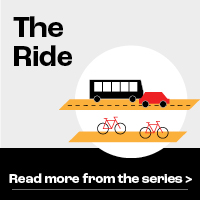There are 1.5 free on-street parking spaces for every car registered in the city, but just one bicycle parking space for every 116 bicycles, according to an analysis by the advocacy group Transportation Alternatives.

Adi Talwar
Bikes in Williamsburg.New Yorkers are no stranger to searching for a place to park—and that goes for cyclists, too.
A report released Tuesday by the advocacy group Transportation Alternatives says the city is in dire need of more parking spaces for bicycles, especially in light of the recent uptick in cycling during the pandemic as New Yorkers look for more socially-distanced ways to get around.
The city is home to 100 times as many parking spaces for cars than for bikes, despite the fact that more New Yorkers own bicycles than vehicles, according to the report. The city’s current inventory of 30,000 bike parking spots across the five boroughs amounts to just one space for every 116* bikes, the report notes, while there are 1.5 free parking spaces on city streets for every registered car.
“Within New York City, bicycle owners are at a significant disadvantage to car owners,” the report reads, calling for the city to “aggressively install on-street bicycle racks until this inequity is corrected.” It says that the city has failed to deliver on a number of previous pledges to increase bike parking capacity, including a 2019 plan to install 1,500 new bike racks each year and another pilot program to build secure bike parking structures on city streets that never came to fruition.
Transportation Alternatives argues that more readily available bike parking would encourage more residents to take up cycling, pointing to a 2007 city survey which found that more than half of the respondents who don’t commute by bike cited lack of safe storage/parking as the reason. It would also help deter bike thefts, which have increased 27 percent during the pandemic, a New York Times report found.
The group is calling for the city to accelerate the installation of bike parking infrastructure alongside its efforts to expand the bike lane and bike share networks, starting in low-income neighborhoods and communities of color. It recommends that the city convert some on-street parking spaces for cars into sites for bike corrals, and to install more bike parking shelters, which are more secure than typical on-street racks and offer protection from the elements.
“Simply put, there is not enough bicycle parking in New York City, and this precludes more New Yorkers from riding bicycles,” the report reads.
In a statement, the city’s Department of Transportation pointed to a number of recent undertakings to improve its bike parking infrastructure, saying the city installed 1,150 bike parking spaces in 2020, including corrals placed outside of hospitals and schools.
Another 13 corrals with space for 200 bikes are expected to be installed this winter, the agency says. City rules usually require that every bike corral installed have a “private partner”—a community group or a local business—to maintain the corrals, but that requirement has been lifted during pandemic recovery efforts to speed up the process.
“We are assessing this model to determine if it can be continued in the future,” DOT said in a statement. “NYC DOT takes bike parking very seriously and contrary to the report has without question brought about a successful broadening of parking availability across the five boroughs, and done so facing Covid-related challenges which created operational challenges impacting several of our priorities.”
Transportation Alternatives has called for the city to update other rules to encourage and make cycling easier, including a zoning regulation that requires developers to build a certain number of parking spots with new residential construction. That rule should be updated “to allow developers flexibility to react to market demands and replace car parking with bicycle parking,” the report recommends.
*Editor’s note: An earlier version of this story contained a typo. The city’s inventory of bike parking spots amounts to just one space for every 116 bikes, not 16, according to the report. We regret the error.










2 thoughts on “City Needs More Bicycle Parking to Meet Surge in New Pandemic Riders, Report Says”
It says that there is one space for every 116 bikes in the byline, but then says 16 later in the article. Please clarify which is accurate.
Eek, my apologies, that was an unfortunate typo — it should read 116. Thank you for catching that discrepancy, it has been corrected.